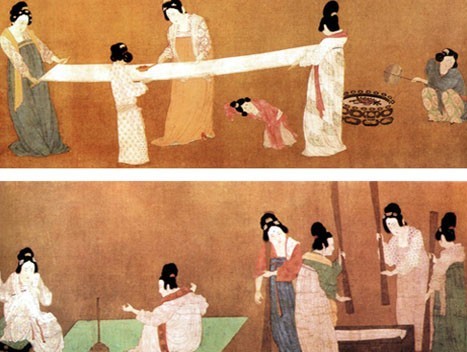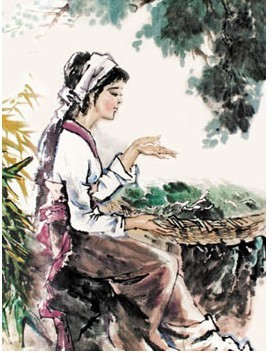| Home > China Feature |
A Short History of Silk in China
One account of the story goes that as she was taking a walk in her husband's gardens, she discovered that silkworms were responsible for the destruction of several mulberry trees. She collected several cocoons and sat down to have a rest. It just so happened that while she was sipping some tea, one of the cocoons that she had collected fell into the hot tea and started to unravel into a fine thread. Hsi Ling Shih found that she could reel this thread around her fingers. Subsequently, she persuaded her husband to allow her to rear silkworms on a grove of mulberry trees, and using the silk reel, an invention of hers, to draw the fibers from the cocoon into a single thread so that they would be strong enough to be weaved into silk. While it is unknown just how much of this is truth or myth, it is certainly true that silk cultivation has existed in China for a very long time. Originally, silk worm farming was solely restricted to women and it was the women who were responsible for the growing, harvesting and weaving. Silk quickly grew into a symbol of status, and originally, only members of the royal family were entitled to wear silk. The rules were gradually relaxed over the years until finally during the Qing Dynasty(1644-1911), even peasants, the lowest caste, were also entitled to wear silk. Sometime during the Han Dynasty(206 BC-220 AD), silk became so valuable that it was also used as a unit of currency. Government officals were paid their salary in bolts of silk and farmers paid their taxes in grain and silk. Silk was also used as diplomatic gifts by the Emperor. From 198 BC to 135 BC, periodic gifts of silk, along with rice and liquor were offered to the Xiongnu in exchange for peace. Silk has historically been used for a number of purposes. Fishing lines, bowstrings, musical instruments and paper were all made using silk. The earliest indication of silk paper being used was found in the tomb of a noble who is estimated to have died around 168 AD. Silk was a closely guarded secret by the Chinese and for hundreds of years, China was the sole producer of silk. However, in 440 AD, a Chinese princess who had been sent off to marry a Khotan prince managed to smuggle silkworm eggs out of China by hiding them in her hairpiece. However, Khotan also kept the secret to themselves, and so it was that up until 550 AD that China, although no longer the sole producer of silk, still managed to mainatin a near monopoly on the market for their silk products. In 550 AD, two monks smuggled silkworm eggs out of China hidden in their hollow bamboo staves. Subsequently the West began cultivating their own silk. While China would continue to maintain dominance in luxury silk items market for a long time, eventually it would lose it's hold during the 11th century with the sudden boom of the silk industry in Italy.

Art
 more
moreChina Beijing International Diet ...
Recently, The hit CCTV documentary, A Bite of China, shown at 10:40 ...

Exhibition of Ancient Chinese Jad...
At least 8,000 years ago, Chinese ancestors discovered a beautiful...

Longmen Grottoes
The Longmen Grottoes, located near Luoyang, Henan Province, are a tr...

Custom
 more
moreWeb Dictionary
Martial Arts
Tai Chi Master Class Held in Moscow
MOSCOW, June 15, 2016 (Xinhua) -- Students learn from Shaolin ...
Celebriting 70 years' efforts in restoring Mogao...
Work is being carried out at the restoration site of cave No 98 a...
Hong Kong Children's Symphony performs in Seattle
Under the theme of Tribute to the Golden Age, a concert featuring a ...





 print
print  email
email  Favorite
Favorite  Transtlate
Transtlate 








